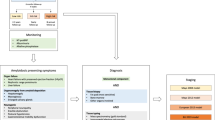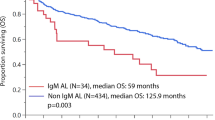Abstract
Light chain deposition disease (LCDD) is caused by a clonal plasma cell disorder in which fragments of monoclonal immunoglobulin light chains form non-fibrillary deposits in various tissues resulting in organ dysfunction. Crystal storing histiocytosis (CSH) is another light chain deposition disorder in which monoclonal light chains form intracytoplasmic crystals. Both are uncommon diseases for which there is limited treatment experience. Between 2003 and 2005, five patients with LCDD and one with CSH were treated at Boston University Medical Center with high-dose melphalan and autologous peripheral blood stem cell transplantation (HDM/SCT). Five of the six patients had predominantly renal involvement, and one patient with LCDD had biopsy-proven deposits in the myocardium. Molecular characterization revealed that the pathologic light chains were κ in four of the six patients, and sequence analysis revealed unusual germline donor genes and high rates of amino-acid substitutions. One light chain sequence encoded a new potential N-linked glycosylation site, and another showed evidence of antigen selection. All patients are alive and five of the six patients are in complete hematologic remission at a median follow-up of 12 months (range 4–29 months) after HDM/SCT. In our experience, HDM/SCT is a feasible and effective treatment approach for these disorders.
This is a preview of subscription content, access via your institution
Access options
Subscribe to this journal
Receive 12 print issues and online access
$259.00 per year
only $21.58 per issue
Buy this article
- Purchase on Springer Link
- Instant access to full article PDF
Prices may be subject to local taxes which are calculated during checkout

Similar content being viewed by others
References
Randall RE, Williamson Jr WC, Mullinax F, Tung NY, Still WJ . Manifestations of systemic light chain deposition. Am J Med 1976; 60: 293–299.
Heilman RL, Velosa JA, Holley KE, Offord KP, Kyle RA . Long-term follow-up and response to chemotherapy in patients with light-chain deposition disease. Am J Kidney Dis 1992; 20: 34–41.
Royer B, Arnulf B, Martinez F, Roy L, Flaguel B, Etienne I et al. High dose chemotherapy in light chain or light and heavy chain deposition disease. Kidney Int 2004; 65: 642–648.
Firkin F, Hill PA, Dwyer K, Gock H . Reversal of dialysis-dependent renal failure in light-chain deposition disease by autologous peripheral blood stem cell transplantation. Am J Kidney Dis 2004; 44: 551–555.
Pozzi C, D'Amico M, Fogazzi GB, Curioni S, Ferrario F, Pasquali S et al. Light chain deposition disease with renal involvement: clinical characteristics and prognostic factors. Am J Kidney Dis 2003; 42: 1154–1163.
Terashima K, Takahashi K, Kojima M, Imai Y, Tsuchida S, Migita S et al. Kappa-type light chain crystal storage histiocytosis. Acta Pathol Jpn 1978; 28: 111–138.
Lebeau A, Zeindl-Eberhart E, Muller EC, Muller-Hocker J, Junbult PR, Emmerich B et al. Generalized crystal-storing histiocytosis associated with monoclonal gammopathy: molecular analysis of a disorder with rapid clinical course and review of the literature. Blood 2002; 100: 1817–1827.
Welschof M, Terness P, Kolbinger F, Zewe M, Dubel S, Dorsam H et al. Amino acid sequence based PCR primers for amplification of rearranged human heavy and light chain immunoglobulin variable region genes. J Immunol Methods 1995; 179: 203–214.
Lossos IS, Tibshirani R, Narasimhan B, Levy R . The inference of antigen selection on Ig genes. J Immunol 2000; 165: 5122–5126.
Lin J, Markowitz GS, Valeri AM, Kambham N, Sherman WH, Appel GB et al. Renal monoclonal immunoglobulin deposition disease: the disease spectrum. J Am Soc Nephrol 2001; 12: 1482–1492.
Sethi S, Cuiffo BP, Pinkus GS, Rennke HG . Crystal-storing histiocytosis involving the kidney in a low-grade B-cell lymphoproliferative disorder. Am J Kidney Dis 2002; 39: 183–188.
Foster SJ, Brezinschek HP, Brezinschek RI, Lipsky PE . Molecular mechanisms and selective influences that shape the kappa gene repertoire of IgM+ B cells. J Clin Invest 1997; 99: 1614–1627.
Deret S, Chomilier J, Huang D, Preud'homme JL, Stevens FJ, Aucouturier P et al. Molecular modeling of immunoglobulin light chains implicates hydrophobic residues in non-amyloid light chain deposition disease. Protein Eng 1997; 10: 1191–1197.
Cogne M, Preud'homme JL, Bauwens M, Touchard G, Aucouturier P . Structure of a monoclonal kappa chain of the V kappa IV subgroup in the kidney and plasma cells in light chain deposition disease. J Clin Invest 1991; 87: 2186–2190.
Child JA, Morgan GJ, Davies FE, Owen RG, Bell SE, Hawkins K et al. High-dose chemotherapy with hematopoietic stem-cell rescue for multiple myeloma. N Engl J Med 2003; 348: 1875–1883.
Attal M, Harousseau JL, Stoppa AM, Sotto JJ, Fuzibet JG, Rossi JF et al. A prospective, randomized trial of autologous bone marrow transplantation and chemotherapy in multiple myeloma. Intergroupe Francais du Myelome. N Engl J Med 1996; 335: 91–97.
Skinner M, Sanchorawala V, Seldin DC, Dember LM, Falk RH, Berk JL et al. High-dose melphalan and autologous stem-cell transplantation in patients with AL amyloidosis: an 8-year study. Ann Intern Med 2004; 140: 85–93.
Acknowledgements
We gratefully acknowledge our colleagues in the Amyloid Treatment and Research Program, Clinical Trials Office and the Center for Cancer and Blood Disorders at Boston University Medical Center who assisted with the multidisciplinary evaluation and treatment of the patients. We are thankful to Dr Thomas Christensen for providing the electron micrograph of the endomyocardial biopsy. Supported by grants from the National Institutes of Health (HL 68705), the Gerry Foundation, and the Amyloid Research Fund at Boston University.
Author information
Authors and Affiliations
Corresponding author
Rights and permissions
About this article
Cite this article
Weichman, K., Dember, L., Prokaeva, T. et al. Clinical and molecular characteristics of patients with non-amyloid light chain deposition disorders, and outcome following treatment with high-dose melphalan and autologous stem cell transplantation. Bone Marrow Transplant 38, 339–343 (2006). https://doi.org/10.1038/sj.bmt.1705447
Received:
Revised:
Accepted:
Published:
Issue Date:
DOI: https://doi.org/10.1038/sj.bmt.1705447
Keywords
This article is cited by
-
The pathogenesis of renal injury and treatment in light chain deposition disease
Journal of Translational Medicine (2019)
-
High-dose melphalan followed by auto-SCT has favorable safety and efficacy in selected patients with light chain deposition disease and light and heavy chain deposition disease
Bone Marrow Transplantation (2012)
-
Crystal-Storing Histiocytosis: Report of a Case, Review of the Literature (80 Cases) and a Proposed Classification
Head and Neck Pathology (2012)
-
Long-term outcome of patients with monoclonal Ig deposition disease treated with high-dose melphalan and stem cell transplantation
Bone Marrow Transplantation (2011)
-
Durable hematological response and improvement of nephrotic syndrome on thalidomide therapy in a patient with refractory light chain deposition disease
International Journal of Hematology (2011)



